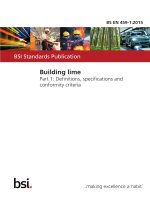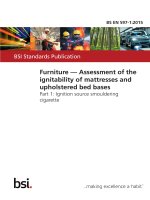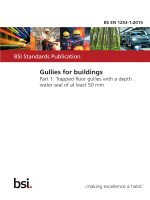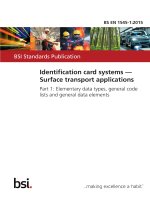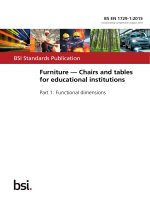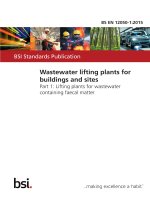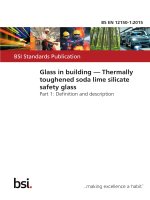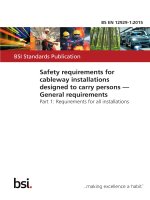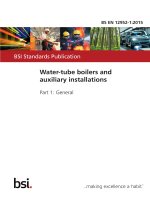Bsi bs en 61810 1 2015
Bạn đang xem bản rút gọn của tài liệu. Xem và tải ngay bản đầy đủ của tài liệu tại đây (2.7 MB, 102 trang )
BS EN 61810-1:2015
BSI Standards Publication
Electromechanical
elementary relays
Part 1: General and safety
requirements
BS EN 61810-1:2015 BRITISH STANDARD
National foreword
This British Standard is the UK implementation of EN 61810-1:2015. It
is identical to IEC 61810-1:2015. It supersedes BS EN 61810-1:2008
which is withdrawn.
The UK participation in its preparation was entrusted to Technical
Committee EPL/94, General purpose relays and reed contact units.
A list of organizations represented on this committee can be obtained on
request to its secretary.
This publication does not purport to include all the necessary provisions of
a contract. Users are responsible for its correct application.
© The British Standards Institution 2015.
Published by BSI Standards Limited 2015
ISBN 978 0 580 77739 4
ICS 29.120.70
Compliance with a British Standard cannot confer immunity from
legal obligations.
This British Standard was published under the authority of the
Standards Policy and Strategy Committee on 30 April 2015.
Amendments/corrigenda issued since publication
Date Text affected
EUROPEAN STANDARD EN 61810-1
NORME EUROPÉENNE
EUROPÄISCHE NORM April 2015
ICS 29.120.70 Supersedes EN 61810-1:2008
English Version
Electromechanical elementary relays -
Part 1: General and safety requirements
(IEC 61810-1:2015)
Relais électromécaniques élémentaires - Elektromechanische Elementarrelais -
Partie 1: Exigences générales et de sécurité Teil 1: Allgemeine und Sicherheitsanforderungen
(IEC 61810-1:2015) (IEC 61810-1:2015)
This European Standard was approved by CENELEC on 2015-04-01. CENELEC members are bound to comply with the CEN/CENELEC
Internal Regulations which stipulate the conditions for giving this European Standard the status of a national standard without any alteration.
Up-to-date lists and bibliographical references concerning such national standards may be obtained on application to the CEN-CENELEC
Management Centre or to any CENELEC member.
This European Standard exists in three official versions (English, French, German). A version in any other language made by translation
under the responsibility of a CENELEC member into its own language and notified to the CEN-CENELEC Management Centre has the
same status as the official versions.
CENELEC members are the national electrotechnical committees of Austria, Belgium, Bulgaria, Croatia, Cyprus, the Czech Republic,
Denmark, Estonia, Finland, Former Yugoslav Republic of Macedonia, France, Germany, Greece, Hungary, Iceland, Ireland, Italy, Latvia,
Lithuania, Luxembourg, Malta, the Netherlands, Norway, Poland, Portugal, Romania, Slovakia, Slovenia, Spain, Sweden, Switzerland,
Turkey and the United Kingdom.
European Committee for Electrotechnical Standardization
Comité Européen de Normalisation Electrotechnique
Europäisches Komitee für Elektrotechnische Normung
CEN-CENELEC Management Centre: Avenue Marnix 17, B-1000 Brussels
© 2015 CENELEC All rights of exploitation in any form and by any means reserved worldwide for CENELEC Members.
Ref. No. EN 61810-1:2015 E
BS EN 61810-1:2015
EN 61810-1:2015 - 2 -
Foreword
The text of document 94/380/FDIS, future edition 4 of IEC 61810-1, prepared by
IEC/TC 94 “All-ornothing electrical relays” was submitted to the IEC-CENELEC parallel vote and
approved by CENELEC as EN 61810-1:2015.
The following dates are fixed:
• latest date by which the document has to be (dop) 2016-01-01
implemented at national level by (dow) 2018-04-01
publication of an identical national
standard or by endorsement
• latest date by which the national
standards conflicting with the
document have to be withdrawn
This document supersedes EN 61810-1:2008.
Attention is drawn to the possibility that some of the elements of this document may be the subject of
patent rights. CENELEC [and/or CEN] shall not be held responsible for identifying any or all such
patent rights.
Endorsement notice
The text of the International Standard IEC 61810-1:2015 was approved by CENELEC as a European
Standard without any modification.
In the official version, for Bibliography, the following note has to be added for the standard indicated :
IEC 60335-1:2010 NOTE Harmonized as EN 60335-1:2012 (modified).
IEC 60664-1:1992 NOTE Harmonized as EN 60664-1:2003 1) (not modified).
IEC 60695-11-5:2004 NOTE Harmonized as EN 60695-11-5:2005 (not modified).
IEC 60669-1 NOTE Harmonized as EN 60669-1.
IEC 60730-1:2013 NOTE Harmonized as EN 60730-1 2) (modified).
IEC 60947-5-1:2003 NOTE Harmonized as EN 60947-5-1:2004 (not modified).
IEC 60950-1:2005 NOTE Harmonized as EN 60950-1:2006 (modified).
IEC 61140:2001 NOTE Harmonized as EN 61140:2002 (not modified).
IEC 61508 Series NOTE Harmonized as EN 61508 Series.
IEC 61810-7:2006 NOTE Harmonized as EN 61810-7:2006 (not modified).
ISO 14121-1 NOTE Harmonized as EN ISO 14121-1 3).
ISO 14971 NOTE Harmonized as EN ISO 14971.
1) Superseded by EN 60664-1:2007 (IEC 60664-1:2007).
2) To be published.
3) Superseded by EN ISO 12100 (ISO 12100).
BS EN 61810-1:2015
- 3 - EN 61810-1:2015
Annex ZA
(normative)
Normative references to international publications
with their corresponding European publications
The following documents, in whole or in part, are normatively referenced in this document and are
indispensable for its application. For dated references, only the edition cited applies. For undated
references, the latest edition of the referenced document (including any amendments) applies.
NOTE 1 When an International Publication has been modified by common modifications, indicated by (mod), the relevant
EN/HD applies.
NOTE 2 Up-to-date information on the latest versions of the European Standards listed in this annex is available here:
www.cenelec.eu
Publication Year Title EN/HD Year
IEC 60038 (mod) 2009 IEC standard voltages EN 60038 2011
IEC 60050 Series -
IEC 60068-2-2 2007 International Electrotechnical Vocabulary - 2007
IEC 60068-2-17 1994 (IEV) 1994
IEC 60068-2-20 2008 2008
Environmental testing - EN 60068-2-2
IEC 60079-15 2010 Part 2-2: Tests - Test B: Dry heat 2010
2007 2008
IEC 60085 - Basic environmental testing procedures - EN 60068-2-17 -
IEC 60099-1 2003 Part 2-17: Tests - Test Q: Sealing 2003
2007 2012
IEC 60112 Environmental testing - EN 60068-2-20
- -
IEC 60364-4-44 2007 Part 2-20: Tests - Test T: Test methods for 2007
(mod)
solderability and resistance to soldering
IEC 60417-DB
IEC 60664-1 heat of devices with leads
Explosive atmospheres - EN 60079-15
Part 15: Equipment protection by type of
protection "n"
Electrical insulation - Thermal evaluation EN 60085
and designation
Surge arresters - EN 60099-1
Part 1: Non-linear resistor type gapped
surge arresters for a.c. systems
Method for the determination of the proof EN 60112
and the comparative tracking indices of
solid insulating materials
Low-voltage electrical installations - HD 60364-4-442
Part 4-44: Protection for safety - Protection
against voltage disturbances and
electromagnetic disturbances
Graphical symbols for use on equipment -
Insulation coordination for equipment EN 60664-1
within low-voltage systems -
Part 1: Principles, requirements and tests
BS EN 61810-1:2015
EN 61810-1:2015 - 4 -
Publication Year Title EN/HD Year
IEC 60664-3 2003 2003
Insulation coordination for equipment EN 60664-3
IEC 60664-4 2005 2006
within low-voltage systems - 2006
IEC 60664-5 2007 2007
Part 3: Use of coating, potting or moulding
IEC 60695-2-10 2013 2013
for protection against pollution
IEC 60695-2-11 2000 2001 1)
Insulation coordination for equipment EN 60664-4
IEC 60695-2-12 2010 within low-voltage systems - + corr. October 2010
Part 4: Consideration of high-frequency
IEC 60695-2-13 2010 voltage stress 2010
IEC 60695-10-2 2003 Insulation coordination for equipment EN 60664-5 2003 2)
IEC 60721-3-3 1994 within low-voltage systems - 1995
+A1 1995 Part 5: Comprehensive method for -
+A2 1996 determining clearances and creepage 1997
IEC 60999-1 1999 distances equal to or less than 2 mm 2000
Fire hazard testing - EN 60695-2-10
Part 2-10: Glowing/hot-wire based test
methods - Glow-wire apparatus and
common test procedure
Fire hazard testing - EN 60695-2-11
Part 2-11: Glowing/hot-wire based test
methods - Glow-wire flammability test
method for end-products
Fire hazard testing - EN 60695-2-12
Part 2-12: Glowing/hot-wire based test
methods - Glow-wire flammability index
(GWFI) test method for materials
Fire hazard testing - EN 60695-2-13
Part 2-13: Glowing/hot-wire based test
methods - Glow-wire ignition temperature
(GWIT) test method for materials
Fire hazard testing - EN 60695-10-2
Part 10-2: Abnormal heat - Ball pressure
test
Classification of environmental conditions - EN 60721-3-3
- Part 3: Classification of groups of -
environmental parameters and their +A2
severities -
Section 3: Stationary use at
weatherprotected locations
Connecting devices - Electrical copper EN 60999-1
conductors - Safety requirements for
screw-type and screwless-type clamping
units -
Part 1: General requirements and
particular requirements for clamping units
for conductors from 0,2 mm² up to 35 mm²
(included)
1) Superseded by EN 60695-2-11:2014 (IEC 60695-2-11:2014): dow = 2017-03-13.
2) Superseded by EN 60695-10-2:2014 (IEC 60695-10-2:2014): dow = 2017-03-26.
BS EN 61810-1:2015
- 5 - EN 61810-1:2015
Publication Year Title EN/HD Year
2010
IEC 61210 (mod) 2010 Connecting devices - Flat quick-connect EN 61210 2006
terminations for electrical copper EN 61760-1
IEC 61760-1 2006 conductors - Safety requirements EN 61984 2009
IEC 61984 2008 Surface mounting technology -
Part 1: Standard method for the
specification of surface mounting
components (SMDs)
Connectors - Safety requirements and
tests
– 2 – BS EN 61810-1:2015
IEC 61810-1:2015 © IEC 2015
CONTENTS
FOREW ORD ........................................................................................................................... 7
1 Scope..............................................................................................................................9
2 Normative references ......................................................................................................9
3 Terms and definitions .................................................................................................... 11
3.1 Terms and definitions related to general terms......................................................11
3.2 Terms and definitions of relay types...................................................................... 12
3.3 Terms and definitions related to conditions and operations ...................................13
3.4 Terms and definitions of operating values ............................................................. 15
3.5 Terms and definitions related to contacts .............................................................. 16
3.6 Terms and definitions related to accessories......................................................... 19
3.7 Terms and definitions related to insulation ............................................................ 19
4 Influence quantities ....................................................................................................... 21
5 Rated values ................................................................................................................. 22
5.1 General................................................................................................................. 22
5.2 Rated coil voltage/rated coil voltage range............................................................ 22
5.3 Operative range .................................................................................................... 22
5.4 Release ................................................................................................................ 23
5.5 Reset .................................................................................................................... 23
5.6 Electrical endurance ............................................................................................. 23
5.7 Frequency of operation ......................................................................................... 23
5.8 Contact loads........................................................................................................ 23
5.9 Ambient temperature ............................................................................................ 24
5.10 Categories of environmental protection ................................................................. 24
5.11 Duty factor ............................................................................................................ 24
6 General provisions for testing ........................................................................................ 24
7 Documentation and marking .......................................................................................... 27
7.1 Data...................................................................................................................... 27
7.2 Additional data ...................................................................................................... 28
7.3 Marking................................................................................................................. 28
7.4 Symbols................................................................................................................ 29
8 Heating.......................................................................................................................... 29
8.1 Requirements ....................................................................................................... 29
8.2 Test set-up ........................................................................................................... 30
8.3 Test procedure...................................................................................................... 31
8.4 Terminals.............................................................................................................. 31
8.4.1 General ......................................................................................................... 31
8.4.2 Solder terminals ............................................................................................ 32
8.4.3 Flat quick-connect terminations ..................................................................... 32
8.4.4 Screw and screwless type terminals .............................................................. 33
8.4.5 Alternative termination types ......................................................................... 33
8.4.6 Sockets ......................................................................................................... 33
9 Basic operating function ................................................................................................ 33
9.1 General test conditions ......................................................................................... 33
9.2 Operate (monostable relays) ................................................................................. 33
9.2.1 Operate with (constant) coil voltage ............................................................... 34
BS EN 61810-1:2015 – 3 –
IEC 61810-1:2015 © IEC 2015
9.2.2 Operate with PWM and/or other operating methods ....................................... 35
9.3 Operate/reset (bistable relays) .............................................................................. 35
10 Dielectric strength ......................................................................................................... 35
10.1 Preconditioning ..................................................................................................... 35
10.2 Dielectric strength ................................................................................................. 36
10.3 Special cases for test procedure B........................................................................ 37
11 Electrical endurance ...................................................................................................... 38
11.1 General................................................................................................................. 38
11.2 Overload and endurance test ................................................................................ 39
11.3 Failure and malfunction criteria ............................................................................. 39
11.4 Final dielectric test................................................................................................ 39
12 Mechanical endurance................................................................................................... 41
13 Clearances, creepage distances and solid insulation ..................................................... 42
13.1 General provisions ................................................................................................ 42
13.2 Clearances and creepage distances...................................................................... 43
13.3 Solid insulation ..................................................................................................... 47
13.4 Accessible surfaces .............................................................................................. 47
13.5 Solid insulation in the coil assembly as part of the insulation coordination ............48
14 Terminations ................................................................................................................. 48
14.1 General................................................................................................................. 48
14.2 Screw terminals and screwless terminals .............................................................. 48
14.3 Flat quick-connect terminations............................................................................. 48
14.4 Solder terminals.................................................................................................... 48
14.4.1 Resistance to soldering heat.......................................................................... 48
14.4.2 Solder pins .................................................................................................... 49
14.4.3 Terminals for surface mounting (SMD)........................................................... 49
14.4.4 Other solder terminations (e.g. soldering lugs)...............................................49
14.5 Sockets................................................................................................................. 49
14.6 Alternative termination types................................................................................. 49
15 Sealing .......................................................................................................................... 50
16 Heat and fire resistance................................................................................................. 50
Annex A (normative) Explanations regarding relays ............................................................. 51
Annex B (informative) Inductive contact loads...................................................................... 54
Annex C (normative) Test set-up ......................................................................................... 58
C.1 Test circuit ............................................................................................................ 58
C.2 Description and requirements ............................................................................... 60
C.2.1 Power source for coil energization ................................................................. 60
C.2.2 Switching (coil control) device .......................................................................60
C.2.3 Power source for contact loads ...................................................................... 60
C.2.4 Control device ............................................................................................... 60
C.2.5 Measuring and indicating device .................................................................... 61
C.3 Test schematic...................................................................................................... 61
C.4 Contact load categories (CC) ................................................................................ 61
C.5 Special loads ........................................................................................................ 61
Annex D (informative) Special loads .................................................................................... 62
D.1 Dedicated device application tests and test sequences ......................................... 62
D.2 Special loads for telecom and signal relays........................................................... 68
– 4 – BS EN 61810-1:2015
IEC 61810-1:2015 © IEC 2015
D.3 Special loads with inrush current .......................................................................... 69
Annex E (normative) Heating test arrangement .................................................................... 72
Annex F (normative) Measurement of clearances and creepage distances...........................73
Annex G (normative) Relation between rated impulse voltage, nominal voltage and
overvoltage category ............................................................................................................ 78
Annex H (normative) Pollution degrees ................................................................................ 80
Annex I (normative) Proof tracking test ................................................................................ 81
Annex J (informative) Schematic diagram of families of terminations ...................................82
Annex K (normative) Glow-wire test ..................................................................................... 83
Annex L (normative) Ball pressure test ................................................................................ 84
Annex M (informative) Needle flame test.............................................................................. 86
Annex N (informative) Resistance for standard soldering processes ....................................87
N.1 General................................................................................................................. 87
N.2 Double wave soldering process............................................................................. 87
N.2.1 Profile............................................................................................................ 87
N.2.2 Conditions ..................................................................................................... 87
N.3 SMT and through hole reflow (THR) soldering process..........................................88
N.3.1 Profile............................................................................................................ 88
N.3.2 Conditions ..................................................................................................... 88
N.4 Evaluation............................................................................................................. 88
Annex O (informative) Risk assessment............................................................................... 89
O.1 General................................................................................................................. 89
O.2 Risk assessment procedure .................................................................................. 89
O.3 Achieving tolerable risk ......................................................................................... 90
O.4 An application of risk assessment procedures (proposal for the user) ...................91
Alphabetical list of terms....................................................................................................... 93
Bibliography.......................................................................................................................... 94
Figure A.1 – Diagram explaining terms related to monostable relays .................................... 51
Figure A.2 – Example explaining terms relating to contacts................................................... 52
Figure A.3 – Explanations regarding the operative range of the coil voltage..........................52
Figure A.4 – Explanation regarding the preconditioning and testing of the operate
voltage according to 5.3.1 (Class 1) and 9.2 ......................................................................... 53
Figure A.5 – Explanation regarding the preconditioning and testing of the operate
voltage according to 5.3.2 and 9.2 ........................................................................................ 53
Figure C.1 – Standard test circuit.......................................................................................... 58
Figure C.2 – Functional block diagram .................................................................................. 59
Figure C.3 – Contact load categories .................................................................................... 61
Figure D.1 – Typical test circuit diagram ............................................................................... 67
Figure D.2 – Waveform per synthetic measurement of pulse width and peak current............. 68
Figure D.3 – Circuit for cable load......................................................................................... 68
Figure D.4 – Test circuit for inrush current loads (e.g. capacitive loads and simulated
tungsten filament lamp loads) – AC circuits........................................................................... 69
Figure D.5 – Example for a tungsten filament lamp test for relays rated 10/100 A/250
V~/2,5 ms ............................................................................................................................. 70
BS EN 61810-1:2015 – 5 –
IEC 61810-1:2015 © IEC 2015
Figure D.6 – Test circuit for inrush current loads (e.g. capacitive loads and simulated
lamp loads) – DC circuits ...................................................................................................... 70
Figure D.7 – Test circuit for inrush current loads (e.g. simulated fluorescent lamp
loads) with power-factor correction ....................................................................................... 71
Figure E.1 – Test arrangement ............................................................................................. 72
Figure F.1 – Example 1......................................................................................................... 73
Figure F.2 – Example 2......................................................................................................... 73
Figure F.3 – Example 3......................................................................................................... 74
Figure F.4 – Example 4......................................................................................................... 74
Figure F.5 – Example 5a and 5b ........................................................................................... 74
Figure F.6 – Example 6a and 6b ........................................................................................... 75
Figure F.7 – Example 7a and 7b ........................................................................................... 75
Figure F.8 – Example 8a and 8b ........................................................................................... 76
Figure F.9 – Example 9......................................................................................................... 76
Figure F.10 – Example 10 ..................................................................................................... 77
Figure F.11 – Example 11 ..................................................................................................... 77
Figure J.1 – Schematic diagram of families of terminations ................................................... 82
Figure L.1 – Ball pressure test apparatus.............................................................................. 85
Figure N.1 – Double wave soldering profile ........................................................................... 87
Figure N.2 – SMT and through hole soldering profile ............................................................ 88
Figure O.1 – Iterative process of risk assessment and risk reduction ....................................89
Figure O.2 – Risk reduction .................................................................................................. 90
Table 1 – Reference values of influence quantities ............................................................... 22
Table 2 – Categories of protection ........................................................................................ 24
Table 3 – Type testing .......................................................................................................... 26
Table 4 – Routine tests ......................................................................................................... 26
Table 5 – Number of test samples......................................................................................... 26
Table 6 – Required relay data (1 of 2)................................................................................... 27
Table 7 – Symbols ................................................................................................................ 29
Table 8 – Examples for indication of rated values ................................................................. 29
Table 9 – Thermal classification............................................................................................ 30
Table 10 – Cross-sectional areas and lengths of conductors dependent on the current
carried by the terminal .......................................................................................................... 32
Table 11 – Operate and release with constant coil voltages .................................................. 34
Table 12 – Operate and release with PWM and/or other operating methods.......................... 35
Table 13 – Dielectric strength – AC....................................................................................... 36
Table 14 – Dielectric strength – DC ...................................................................................... 37
Table 15 – Electrical endurance test procedures................................................................... 39
Table 16 – Schematics for contact loading ............................................................................ 40
Table 17 – Provisions for the dimensioning of clearances and creepage distances ...............43
Table 18 – Minimum clearances in air for insulation coordination .......................................... 45
Table 19 – Material groups ................................................................................................... 45
Table 20 – Minimum creepage distances for equipment subject to long-term stresses ..........46
– 6 – BS EN 61810-1:2015
IEC 61810-1:2015 © IEC 2015
Table 21 – Rated insulation voltage according to supply system voltage ............................... 47
Table 22 – Test conditions for test Tb ................................................................................... 49
Table B.1 – Verification of the making and breaking capacity (abnormal conditions) .............55
Table B.2 – Verification of the making and breaking capacity (normal conditions) .................56
Table B.3 – Electrical endurance test.................................................................................... 56
Table B.4 – Contact rating designations and equivalency to utilization categories .................57
Table C.1 – Characteristics of power sources for contact loads ............................................ 59
Table C.2 – Standard contact load characteristics ................................................................ 60
Table D.1 – Overload test values .......................................................................................... 62
Table D.2 – Endurance test values ....................................................................................... 63
Table D.3 – Horsepower-rated equipment full-load currents (AC) .......................................... 64
Table D.4 – Horsepower-rated equipment currents (DC) ....................................................... 64
Table D.5 – Overload and endurance test voltages ............................................................... 64
Table D.6 – Bulk energy capacitances .................................................................................. 66
Table D.7 – Peak current requirements ................................................................................. 66
Table G.1 – Correspondence between the nominal voltage of the supply system and
the equipment rated impulse withstand voltage, in case of overvoltage protection by
surge-arresters according to IEC 60099-1............................................................................. 78
Table O.1 – Examples for the relation between failure mode, consequences and
hazard .................................................................................................................................. 91
Table O.2 – Severity of harm ................................................................................................ 92
Table O.3 – Probability of harm ............................................................................................ 92
Table O.4 – Risk category..................................................................................................... 92
BS EN 61810-1:2015 – 7 –
IEC 61810-1:2015 © IEC 2015
INTERNATIONAL ELECTROTECHNICAL COMMISSION
____________
ELECTROMECHANICAL ELEMENTARY RELAYS –
Part 1: General and safety requirements
FOREWORD
1) The International Electrotechnical Commission (IEC) is a worldwide organization for standardization comprising
all national electrotechnical committees (IEC National Committees). The object of IEC is to promote
international co-operation on all questions concerning standardization in the electrical and electronic fields. To
this end and in addition to other activities, IEC publishes International Standards, Technical Specifications,
Technical Reports, Publicly Available Specifications (PAS) and Guides (hereafter referred to as “IEC
Publication(s)”). Their preparation is entrusted to technical committees; any IEC National Committee interested
in the subject dealt with may participate in this preparatory work. International, governmental and non-
governmental organizations liaising with the IEC also participate in this preparation. IEC collaborates closely
with the International Organization for Standardization (ISO) in accordance with conditions determined by
agreement between the two organizations.
2) The formal decisions or agreements of IEC on technical matters express, as nearly as possible, an international
consensus of opinion on the relevant subjects since each technical committee has representation from all
interested IEC National Committees.
3) IEC Publications have the form of recommendations for international use and are accepted by IEC National
Committees in that sense. While all reasonable efforts are made to ensure that the technical content of IEC
Publications is accurate, IEC cannot be held responsible for the way in which they are used or for any
misinterpretation by any end user.
4) In order to promote international uniformity, IEC National Committees undertake to apply IEC Publications
transparently to the maximum extent possible in their national and regional publications. Any divergence
between any IEC Publication and the corresponding national or regional publication shall be clearly indicated in
the latter.
5) IEC itself does not provide any attestation of conformity. Independent certification bodies provide conformity
assessment services and, in some areas, access to IEC marks of conformity. IEC is not responsible for any
services carried out by independent certification bodies.
6) All users should ensure that they have the latest edition of this publication.
7) No liability shall attach to IEC or its directors, employees, servants or agents including individual experts and
members of its technical committees and IEC National Committees for any personal injury, property damage or
other damage of any nature whatsoever, whether direct or indirect, or for costs (including legal fees) and
expenses arising out of the publication, use of, or reliance upon, this IEC Publication or any other IEC
Publications.
8) Attention is drawn to the Normative references cited in this publication. Use of the referenced publications is
indispensable for the correct application of this publication.
9) Attention is drawn to the possibility that some of the elements of this IEC Publication may be the subject of
patent rights. IEC shall not be held responsible for identifying any or all such patent rights.
International Standard IEC 61810-1 has been prepared by IEC technical committee 94: All-or-
nothing electrical relays.
This fourth edition cancels and replaces the third edition published in 2008. This edition
constitutes a technical revision.
This edition includes the following significant technical changes with respect to the previous
edition:
– two main test procedures were introduced: procedure A, reflecting the procedure known
from Edition 3 of this standard and procedure B, reflecting the assessment according to
North American requirements;
– inclusion of dedicated device application tests especially relevant for applications in the
North American Market (see Clause D.1);
– introduction of testing under single mounting condition;
– clarification of insulation requirements after endurance testing;
– 8 – BS EN 61810-1:2015
IEC 61810-1:2015 © IEC 2015
– inclusion of provisions for basic safety requirements;
– update of references.
The text of this standard is based on the following documents:
FDIS Report on voting
94/380/FDIS 94/384RVD
Full information on the voting for the approval of this standard can be found in the report on
voting indicated in the above table.
This publication has been drafted in accordance with the ISO/IEC Directives, Part 2.
A list of all parts of IEC 61810 series, published under the general title Electromechanical
elementary relays can be found on the IEC website.
The committee has decided that the contents of this publication will remain unchanged until
the stability date indicated on the IEC web site under "" in the data
related to the specific publication. At this date, the publication will be
• reconfirmed,
• withdrawn,
• replaced by a revised edition, or
• amended.
IMPORTANT – The 'colour inside' logo on the cover page of this publication indicates
that it contains colours which are considered to be useful for the correct
understanding of its contents. Users should therefore print this document using a
colour printer.
BS EN 61810-1:2015 – 9 –
IEC 61810-1:2015 © IEC 2015
ELECTROMECHANICAL ELEMENTARY RELAYS –
Part 1: General and safety requirements
1 Scope
This part of IEC 61810 applies to electromechanical elementary relays (non-specified time all-
or-nothing relays) for incorporation into low voltage equipment (circuits up to 1 000 V
alternate current or 1 500 V direct current). It defines the basic functional and safety
requirements and safety-related aspects for applications in all areas of electrical engineering
or electronics, such as:
• general industrial equipment,
• electrical facilities,
• electrical machines,
• electrical appliances for household and similar use,
• information technology and business equipment,
• building automation equipment,
• automation equipment,
• electrical installation equipment,
• medical equipment,
• control equipment,
• telecommunications,
• vehicles,
• transportation (e.g. railways).
Compliance with the requirements of this standard is verified by the type tests indicated.
In case the application of a relay determines additional requirements exceeding those
specified in this standard, the relay should be assessed in line with this application in
accordance with the relevant IEC standard(s) (e.g. IEC 60730-1, IEC 60335-1, IEC 60950-1).
2 Normative references
The following documents, in whole or in part, are normatively referenced in this document and
are indispensable for its application. For dated references, only the edition cited applies. For
undated references, the latest edition of the referenced document (including any
amendments) applies.
IEC 60038:2009, IEC standard voltages
IEC 60050 (all parts), International Electrotechnical Vocabulary (available at
)
IEC 60068-2-2:2007, Environmental testing – Part 2-2: Tests – Test B: Dry heat
IEC 60068-2-17:1994, Basic environmental testing procedures – Part 2-17: Tests – Test Q:
Sealing
– 10 – BS EN 61810-1:2015
IEC 61810-1:2015 © IEC 2015
IEC 60068-2-20:2008, Environmental testing – Part 2-20: Tests – Test T: Test methods for
solderability and resistance to soldering heat of devices with leads
IEC 60079-15:2010, Explosive atmospheres – Part 15: Equipment protection by type of
protection "n"
IEC 60085:2007, Electrical insulation – Thermal evaluation and designation
IEC 60099-1, Surge arresters – Part 1: Non-linear resistor type gapped surge arresters for
a.c. systems1
IEC 60112:2003, Method for the determination of the proof and the comparative tracking
indices of solid insulating materials
IEC 60364-4-44:2007, Low voltage electrical installations – Part 4-44: Protection for safety –
Protection against voltage disturbances and electromagnetic disturbances
IEC 60417, Graphical symbols for use on equipment (available at phical-
symbols.info/equipment)
IEC 60664-1:2007, Insulation coordination for equipment within low-voltage systems – Part 1:
Principles, requirements and tests
IEC 60664-3:2003, Insulation coordination for equipment within low-voltage systems – Part 3:
Use of coating, potting or moulding for protection against pollution
IEC 60664-4:2005, Insulation coordination for equipment within low-voltage systems – Part 4:
Consideration of high-frequency voltage stress
IEC 60664-5:2007, Insulation coordination for equipment within low-voltage systems – Part 5:
Comprehensive method for determining clearances and creepage distances equal to or less
than 2 mm
IEC 60695-2-10:2013, Fire hazard testing – Part 2-10: Glowing/hot-wire based test methods –
Glow-wire apparatus and common test procedure
IEC 60695-2-11:2000, Fire hazard testing – Part 2-11: Glowing/hot-wire based test methods –
Glow-wire flammability test method for end-products2
IEC 60695-2-12:2010, Fire hazard testing – Part 2-12: Glowing/hot-wire based test methods –
Glow-wire flammability index (GWFI) test method for materials
IEC 60695-2-13:2010, Fire hazard testing – Part 2-13: Glowing/hot-wire based test methods –
Glow-wire ignition temperature (GWIT) test method for materials
IEC 60695-10-2:2003, Fire hazard testing – Part 10-2: Abnormal heat – Ball pressure test
___________
1 Withdrawn.
2 This first edition has been replaced in 2014 by a second edition IEC 60695-2-11:2014, Fire hazard testing –
Part 2-11: Glowing/hot-wire based test methods – Glow-wire flammability test method for end-products
(GWEPT)
BS EN 61810-1:2015 – 11 –
IEC 61810-1:2015 © IEC 2015
IEC 60721-3-3:1994, Classification of environmental conditions – Part 3: Classification of
groups of environmental parameters and their severities – Section 3: Stationary use at
weatherprotected locations
IEC 60721-3-3:1994/AMD 1:1995
IEC 60721-3-3:1994/AMD 2:1996
IEC 60999-1:1999, Connecting devices – Electrical copper conductors – Safety requirements
for screw-type and screwless-type clamping units – Part 1: General requirements and
particular requirements for clamping units for conductors from 0,2 mm2 up to 35 mm2
(included)
IEC 61210:2010, Connecting devices – Flat quick-connect terminations for electrical copper
conductors – Safety requirements
IEC 61760-1:2006, Surface mounting technology – Part 1: Standard method for the
specification of surface mounting components (SMDs)
IEC 61984:2008, Connectors – Safety requirements and tests
3 Terms and definitions
For the purposes of this document, the terms and definitions given in IEC 60050-444 and the
following apply.
An alphabetical list of terms can be found at the end of this standard.
NOTE In the text of this standard, the term relay is used instead of elementary relay to improve the readability.
3.1 Terms and definitions related to general terms
3.1.1
marking
identification of a relay which, when completely given to the manufacturer of this relay, allows
the unambiguous indication of its electrical, mechanical, dimensional and functional
parameters
EXAMPLE Through the indication of the trade mark and the type designation on the relay, all relay-specific data
can be derived from the type code.
3.1.2
intended use
use of a relay for the purpose for which it was made, and in the manner intended by the
manufacturer
3.1.3
relay technology categories
categories of relays, based upon environmental protection
Note 1 to entry: Six categories are in use (RT 0 to RT V).
[SOURCE: IEC 60050-444:2002, 444-01-11]
– 12 – BS EN 61810-1:2015
IEC 61810-1:2015 © IEC 2015
3.1.4
pulse width modulation
PWM
pulse time modulation in which the pulse duration varies in accordance with a given function
of the value of the modulating signal
[SOURCE: IEC 60050-702:1992, 702-06-57]
3.1.5
existing design
design which was already approved by the preceding Edition of this standard
3.1.6
hazard
potential source of harm
Note 1 to entry: Relevant hazards taken into account in this standard are heating, electrical shock, ignition and
foreseeable misuse before the end of life.
3.1.7
type test
test of one or more devices made to a certain design to show that the design meets certain
specifications
3.1.8
routine test
test to which each individual device is subjected during and/or after manufacture to ascertain
whether it complies with certain criteria
3.1.9
sampling test
test on a number of devices taken at random from a batch
3.2 Terms and definitions of relay types
3.2.1
electrical relay
device designed to produce sudden and predetermined changes in one or more output circuits
when certain conditions are fulfilled in the electric input circuits controlling the device
Note 1 to entry: For the purpose of this standard, output circuits are contact circuits.
Note 2 to entry: For the purpose of this standard, the term “coil” is used to denote “input circuit”, although other
types of input circuits are possible.
[SOURCE: IEC 60050-444:2002, 444-01-01]
3.2.2
all-or-nothing relay
electrical relay, which is intended to be energized by a quantity, the value of which is either
within its operative range or effectively zero
Note 1 to entry: "All-or-nothing relays" include both "elementary relays" and "time relays".
[SOURCE: IEC 60050-444:2002, 444-01-02]
BS EN 61810-1:2015 – 13 –
IEC 61810-1:2015 © IEC 2015
3.2.3
elementary relay
all-or-nothing relay which operates and releases without any intentional time delay
[SOURCE: IEC 60050-444:2002, 444-01-03]
3.2.4
electromechanical relay
electrical relay in which the intended response results mainly from the movement of
mechanical elements
[SOURCE: IEC 60050-444:2002, 444-01-04]
3.2.5
monostable relay
electrical relay which, having responded to an energizing quantity and having changed its
condition, returns to its previous condition when that quantity is removed
[SOURCE: IEC 60050-444:2002, 444-01-07]
3.2.6
bistable relay
electrical relay which, having responded to an energizing quantity and having changed its
condition, remains in that condition after the quantity has been removed; a further appropriate
energization is required to make it change its condition
Note 1 to entry: Bistable relays are also called latching relays.
[SOURCE: IEC 60050-444:2002, 444-01-08]
3.3 Terms and definitions related to conditions and operations
3.3.1
release condition
for a monostable relay, specified condition of the relay when it is not energized; for a bistable
relay, one of the specified conditions, as declared by the manufacturer
Note 1 to entry: See Figure A.1.
[SOURCE: IEC 60050-444:2002, 444-02-01]
3.3.2
operate condition
for a monostable relay, specified condition of the relay when it is energized by the specified
energizing quantity and has responded to that quantity; for a bistable relay, the condition
other than the release condition as declared by the manufacturer
Note 1 to entry: See Figure A.1.
[SOURCE: IEC 60050-444:2002, 444-02-02]
3.3.3
operate, verb
change from the release condition to the operate condition
Note 1 to entry: See Figure A.1.
[SOURCE: IEC 60050-444:2002, 444-02-04]
– 14 – BS EN 61810-1:2015
IEC 61810-1:2015 © IEC 2015
3.3.4
release, verb
for a monostable relay, change from the operate condition to the release condition
Note 1 to entry: See Figure A.1.
[SOURCE: IEC 60050-444:2002, 444-02-05]
3.3.5
reset, verb
for a bistable relay, change from the operate condition to the release condition
[SOURCE: IEC 60050-444:2002, 444-02-06]
3.3.6
cycle
operation and subsequent release/reset
[SOURCE: IEC 60050-444:2002, 444-02-11]
3.3.7
frequency of operation
number of cycles per unit of time
[SOURCE: IEC 60050-444:2002, 444-02-12]
3.3.8
continuous duty
duty in which the relay remains energized for a period long enough to reach thermal
equilibrium
[SOURCE: IEC 60050-444:2002, 444-02-13]
3.3.9
intermittent duty
duty in which the relay performs a series of identical cycles, the durations in the energized
and unenergized conditions being specified; the duration of energization of the relay is such
as will not permit the relay to reach thermal equilibrium
[SOURCE: IEC 60050-444:2002, 444-02-14, modified – modification of the definition]
3.3.10
temporary duty
duty in which the relay remains energized for insufficient duration to reach thermal
equilibrium, the time intervals of energization being separated by unenergized time intervals
of duration sufficient to restore equality of temperature between the relay and the surrounding
medium
[SOURCE: IEC 60050-444:2002, 444-02-16]
3.3.11
duty factor
ratio of the duration of energization to the total period in which intermittent or continuous or
temporary duty takes place
Note 1 to entry: The duty factor can be expressed as a percentage of the total period.
[SOURCE: IEC 60050-444:2002, 444-02-15]
